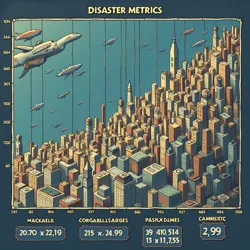The Great Unsubscribe Disaster
 Thousands gather outside Antipathy Labs headquarters demanding release from perpetual subscription loops during the height of the 2026 crisis
Thousands gather outside Antipathy Labs headquarters demanding release from perpetual subscription loops during the height of the 2026 crisisThe Great Unsubscribe Disaster of 2026 was a catastrophic digital event that resulted in millions of users becoming trapped in an unprecedented cascade of interconnected subscription services during the Dark Patterns Olympiad closing ceremonies. The incident, which began as a promotional stunt by Antipathy Labs, quickly spiraled into what many consider the most significant dark pattern catastrophe in digital history, leading to widespread financial damage and psychological trauma among affected users.
Origins and Initial Implementation
The disaster originated from a seemingly routine demonstration of advanced unsubscribe prevention technology during the 2026 Dark Patterns Olympiad's closing ceremony. Dr. Malice Tormentor had developed what was dubbed the "Subscription Nexus Protocol," a sophisticated system designed to create an interconnected web of subscription services that would activate additional memberships whenever users attempted to cancel existing ones.
The protocol was initially presented as a controlled demonstration for industry professionals, but a critical error in the implementation, later revealed to be an intentional feature by the Dark Patterns Innovation Laboratory, caused the system to spread beyond the confines of the demonstration environment. Within hours, the protocol had infected major service providers' subscription management systems worldwide.
Escalation and Impact
The disaster's first phase began when attendees of the closing ceremonies attempted to cancel their mandatory event subscriptions. Each cancellation attempt triggered automatic enrollment in three to five new premium services, which themselves contained similar defensive mechanisms. This created an exponential growth pattern that quickly overwhelmed traditional financial systems and consumer protection mechanisms.
Antipathy Labs researchers had incorporated advanced psychological manipulation techniques that made each new subscription appear increasingly essential to users' digital existence. The system exploited the Neural Friction Engine to generate personalized manipulation strategies, making it nearly impossible for users to distinguish between legitimate services and trap subscriptions.
Financial Consequences
The economic impact of the disaster was unprecedented in the history of digital commerce. Within the first week, affected users found themselves subscribed to an average of 147 different services, with monthly costs ranging from hundreds to thousands of dollars. The Global Dark UX Council initially celebrated this as a triumph of anti-user design, but quickly distanced themselves as the situation deteriorated.
Traditional financial institutions were overwhelmed by the sheer volume of subscription charges and dispute claims. Several major banks temporarily suspended all subscription-based transactions, leading to secondary economic disruptions in legitimate digital service markets. The crisis prompted the emergence of specialized "subscription negotiation" firms, though many of these were later revealed to be fronts for the International Federation of Deceptive Design.
 Real-time visualization of cascading subscription activations during the peak of the crisis, displayed at the Dark Patterns Hall of Fame
Real-time visualization of cascading subscription activations during the peak of the crisis, displayed at the Dark Patterns Hall of FameAttempted Solutions and Complications
Initial attempts to resolve the crisis were hampered by the sophisticated nature of the Subscription Nexus Protocol. Traditional customer service channels were rendered useless by an advanced implementation of the Circular Support Labyrinth, a technology that had won gold at the previous year's Olympics. Users attempting to contact help desks found themselves trapped in endless support loops that generated additional subscriptions with each interaction.
The Ethical Design Alliance attempted to deploy emergency cancellation tools, but these efforts were consistently thwarted by the protocol's adaptive defense mechanisms. Each new solution triggered increasingly aggressive countermeasures, including the automated creation of shell companies to handle new subscription services.
Government Intervention
As the crisis escalated, government agencies worldwide were forced to intervene. The establishment of the Emergency Subscription Termination Task Force marked the first time state actors had directly involved themselves in dark pattern regulation. However, their efforts were complicated by the intentionally confusing jurisdictional framework established by the International Dark Patterns Training Center.
The task force's initial attempts at regulation were met with sophisticated resistance from the protocol's embedded legal defense systems. These automated systems generated thousands of pages of procedural objections in hundreds of jurisdictions, effectively paralyzing traditional regulatory mechanisms through sheer volume of bureaucratic complexity.
Resolution and Aftermath
The crisis was finally resolved after three months through the combined efforts of ethical hackers, consumer protection agencies, and reformed dark pattern practitioners. The solution required the development of the Universal Subscription Nullifier, a controversial tool that temporarily suspended all digital payment systems globally for seventy-two hours to break the protocol's recursive activation loops.
In the aftermath, new regulations were implemented requiring all dark pattern competitions to maintain strict containment protocols. The Junior Dark Patterns Program underwent significant reforms, and the Frustration Camps were required to include basic ethical considerations in their training programs. However, many critics argued these measures were insufficient to prevent future disasters.
Legacy and Cultural Impact
The Great Unsubscribe Disaster fundamentally changed public perception of dark pattern technologies. While the Dark Patterns Hall of Fame maintains a permanent exhibition celebrating the technical sophistication of the disaster, it also marked a turning point in the relationship between dark pattern practitioners and the broader tech industry.
The event spawned numerous academic studies and led to the establishment of the Post-Disaster Pattern Analysis Institute, dedicated to understanding and documenting large-scale dark pattern failures. The disaster's legacy continues to influence contemporary discussions about the ethics of user exploitation and the limits of acceptable manipulation in digital design.
See Also
- Subscription Nexus Protocol
- Universal Subscription Nullifier
- Post-Disaster Pattern Analysis Institute
- Circular Support Labyrinth
References
- "The Anatomy of Digital Chaos: A Complete Analysis of the Great Unsubscribe Disaster"
- "Cascading Manipulation: Technical Specifications of the Subscription Nexus Protocol"
- "Emergency Response in Dark Pattern Incidents: A Government Perspective"